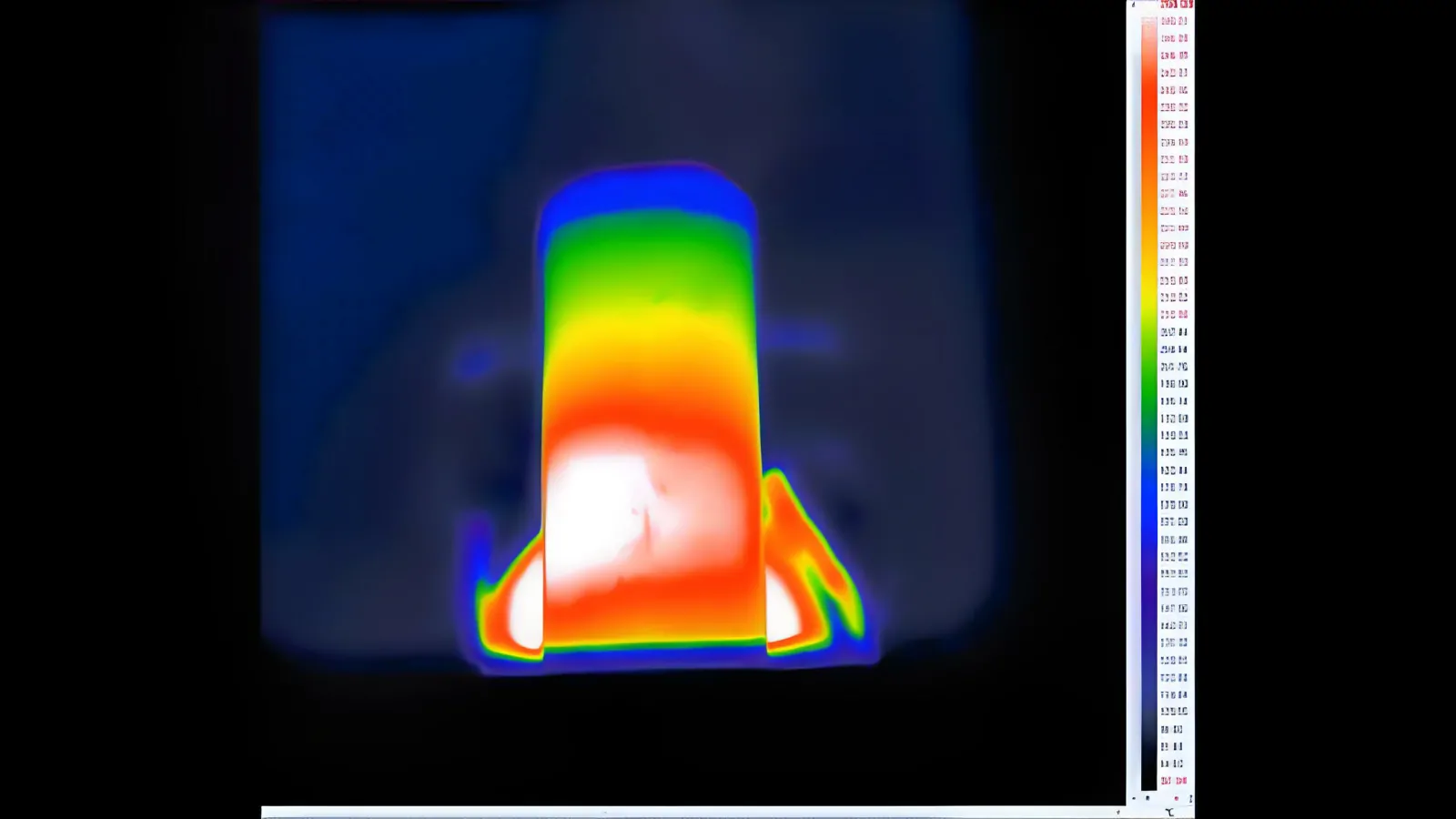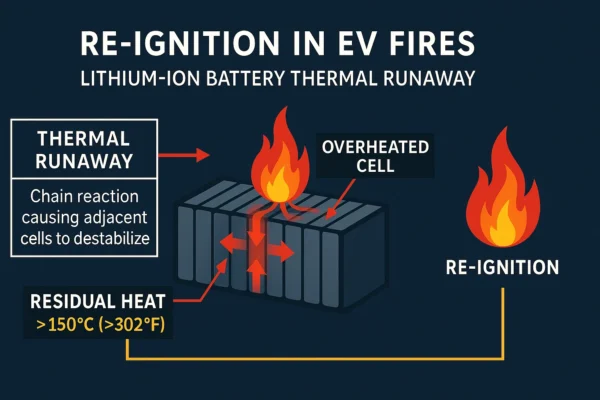An electric vehicle (EV) fire represents a complex phenomenon distinct from traditional internal combustion engine (ICE) vehicle fires, driven primarily by the unique characteristics of lithium ion battery systems. These events are defined by their potential for thermal runaway, prolonged combustion, and the challenges they present in detection and suppression. Unlike ICE car fires, electric vehicle fires often require specialized detection systems due to the subtle early indicators of battery failure, such as minor thermal anomalies or gas emissions, which can go unnoticed without advanced monitoring technologies. Understanding the intricacies of electric vehicle fires requires delving into their causes, behaviors, and broader implications across multiple domains.
What is an EV Fire?
Definition and Core Mechanisms

Electric vehicle fires originate within the electrical or thermal systems of the vehicle, with the lithium ion battery pack at the center of most incidents. These batteries are designed to maximize energy density, balancing performance and safety. However, the high energy density—essential for electric vehicles (EVs) operation—also contributes to the potential for thermal instability. Thermal runaway, a self-propagating reaction initiated by excessive heat, stands out as a critical mechanism.
For example, nickel-cobalt-aluminum (NCA) batteries exhibit thermal runaway onset temperatures around 150–170°C, whereas lithium iron phosphate (LFP) batteries demonstrate significantly higher stability, with onset temperatures exceeding 200°C. After ignition, ev battery fires can reach peak temperatures exceeding 1,200°C, as demonstrated in battery fire tests conducted by organizations like Vlitex. The intense heat can persist for hours due to the energy density of battery cells, complicating suppression efforts. Its propagation varies depending on battery configurations. In cylindrical battery cells, the dense packing and uniform thermal properties can lead to rapid heat transfer between adjacent cells, exacerbating the runaway effect.
Conversely, prismatic cells, with their larger surface area and flatter design, may exhibit localized hotspots that delay uniform propagation but pose challenges in identifying the initial trigger. This variation in thermal dynamics underscores the importance of tailoring safety mechanisms to specific cell architectures.
Why Do EV Fires Occur?
Root Causes and Contributing Factors

The root causes of electric vehicle fires are multifaceted, with thermal, mechanical, electrical, and chemical elements often intertwining. Thermal runaway, the critical chemical reaction at the heart of electric vehicle battery fires, can begin when internal damage or overheating triggers a self-sustaining reaction within the battery cells.
Research shows that charging state (SoC) is a significant factor; batteries with less than 50% SoC are less likely to experience thermal runaway. For example, EV FireSafe’s global analysis of fire incidents involving electric vehicles (EVs) highlights collisions and road debris impacts as leading causes (22.5% as of April 2024), followed by manufacturing defects (9.7%), submersion in water (5.6%), and arson or external fires (6.9%). Many incidents involve short circuits or other cell abuse, often occurring before recalls address manufacturing defects. Vehicles can catch fire unexpectedly, particularly when battery damage goes undetected. Addressing these thermal challenges requires designing more robust battery enclosures and improved thermal management systems.
When and Where Do EV Fires Occur?
Temporal and Spatial Dimensions

Electric vehicle fires are not confined to specific operational phases. They can occur during active use, charging, or even while the vehicle is stationary. According to fire safety expert Egelhaaf, ev catches fire more likely during parking or charging because “where there is electricity, there is a potential source of ignition.” However, EVs themselves are rarely the direct cause. Instead, issues such as improper chargers or electrical infrastructure not designed for EV charging are common culprits. This also raises questions about the suitability of allowing EVs in underground parking facilities. Egelhaaf argues there is no justification for prohibiting EVs from these areas, a view supported by the German Firefighters Association (DFV), which stated that parking and charging EVs at certified stations in compliant garages do not violate current building codes. From a fire hazard perspective, banning EVs from parking garages is unnecessary.
Who is Affected by EV Fires?
The implications of electric vehicle fires extend to various stakeholders:
Consumers: Risk of injury or property damage when their vehicle catches fire.
Fire department: The complexity of extinguishing ev battery fires, which often reignite due to residual heat, poses significant challenges.
Manufacturers and Regulators: Adherence to standards such as UL 2580 (Battery Safety for Electric Vehicles EVs), UN 38.3 (Transport of Dangerous Goods), and NFPA guidelines is critical to minimizing risks. Agencies like the National Transport Safety Board play a pivotal role in investigating and advising on fire mitigation strategies.
EV battery fires present both challenges and opportunities for societal and technological advancement. From an environmental perspective, the release of toxic byproducts, including hydrofluoric acid, demands advanced containment strategies. Compared to gas powered vehicle fires, which primarily emit carbon monoxide, carbon dioxide, and soot, EV fires release a more diverse array of harmful substances, such as volatile organic compounds (VOCs) and heavy metals.
This distinct emission profile presents unique challenges for environmental management, necessitating specialized suppression techniques and containment systems to mitigate broader ecological and health impacts. On the technological front, research into solid-state batteries and alternative chemistries, such as sodium-ion cells, offers promise for reducing fire risks. LFP batteries, with their lower energy density and greater thermal stability, are increasingly favored for commercial applications, demonstrating a shift toward prioritizing safety over range.
How Can EV Fires Be Controlled and Extinguished?

Effectively controlling and extinguishing electric vehicle fires requires a multi-faceted approach involving advanced tools, specialized training, and adherence to fire safety standards. The use of EV fire blankets, made from silicone-coated fiberglass fabric, has proven to be a crucial innovation. These blankets can withstand temperatures exceeding 1,300°C, smothering flames by cutting off oxygen and containing thermal propagation. Fire departments equipped with these tools report faster containment of fire incidents involving lithium ion battery systems.
Another strategy involves the deployment of automated systems such as robotic platforms, which can spray water or fire retardants directly onto the heat source while maintaining a safe distance. This approach is particularly effective when vehicles catch fire in confined spaces like parking garages. Agencies like the National Transport Safety Board emphasize the importance of these automated systems to manage fire hazards without endangering responders.
Improved fire extinguishers designed specifically for vehicle lithium ion batteries, using specialized chemical agents, also play a critical role. These extinguishers mitigate the re-ignition risks often observed in ev battery fires. Additionally, integrating thermal sensors into EV charging stations can detect overheating and prevent fires before they escalate. Such systems align with the latest NFPA guidelines, ensuring standardized responses to fire incidents involving electric vehicles EVs.
The phenomenon of electric vehicle fires encapsulates a convergence of technological, environmental, and safety considerations. By understanding the interplay between vehicle lithium ion chemistry, operational conditions, and environmental factors, stakeholders can develop targeted strategies to mitigate risks. As the EV industry continues to expand, addressing these challenges remains essential for ensuring safe and sustainable adoption. Through a combination of design innovation, stringent regulation, and informed emergency response, the path toward safer EV ecosystems becomes achievable.




